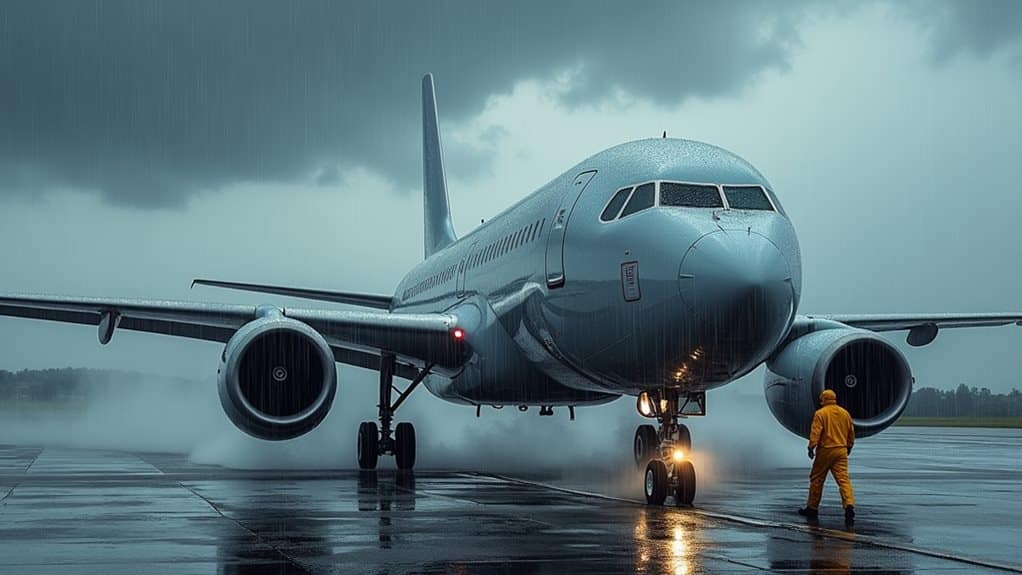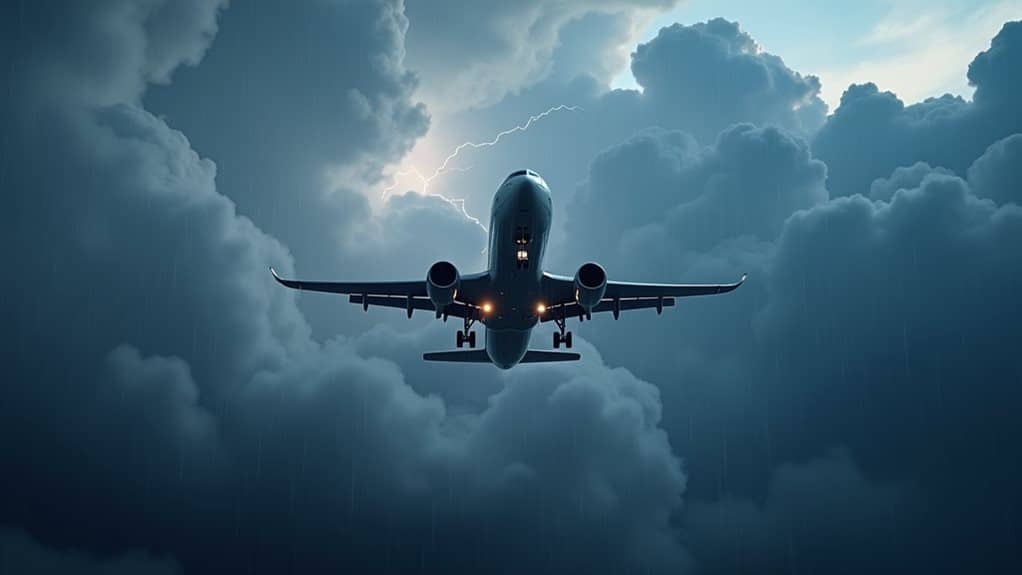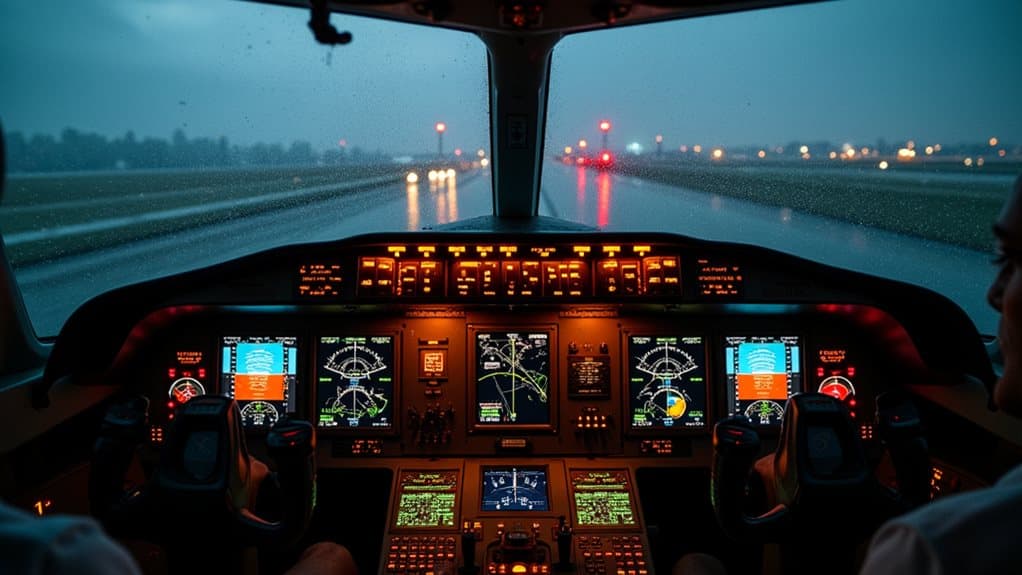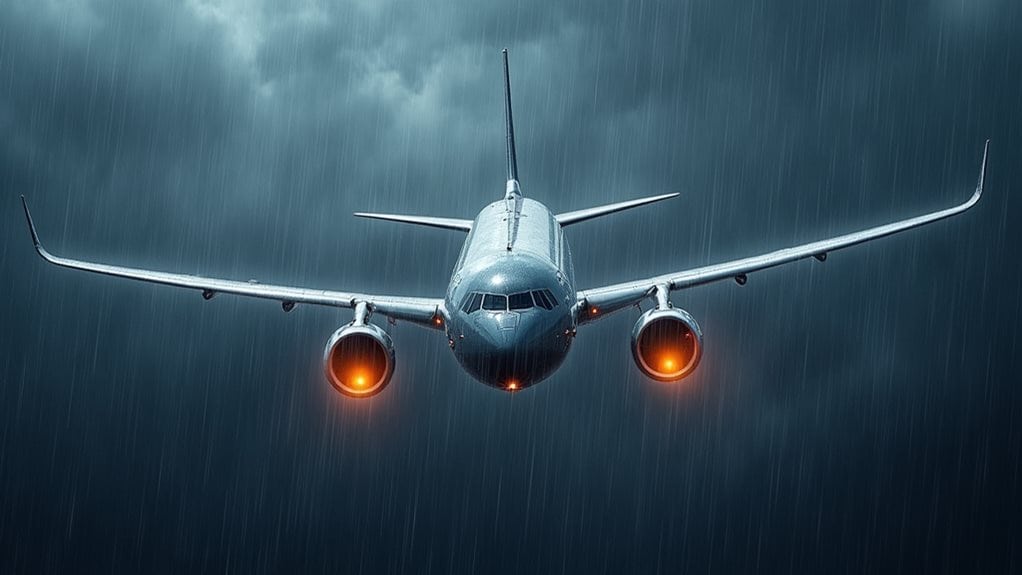Yes, you can fly safely in rain because modern aircraft feature integrated waterproofing systems, sealed motor housings, and specialized gaskets that prevent water infiltration. While rain increases drag by up to 40% and reduces visibility during takeoff and landing, pilots use weather radar and instrument guidance to maintain safety. Airlines prioritize passenger security through thorough protocols and advanced technology, though minor delays may occur. Understanding how aircraft handle wet weather conditions and when real concerns arise will help you travel with confidence.
TLDR
- Yes, airplanes can fly safely in rain due to advanced waterproofing systems and sealed components that prevent water ingress.
- Rain increases drag by 40% and reduces lift by 18%, requiring pilots to adjust speeds and fuel consumption accordingly.
- Takeoff and landing are most challenging in rain due to reduced visibility, wet runways, and increased hydroplaning risks.
- Pilots use weather radar and instruments to navigate safely through rain while avoiding severe weather like thunderstorms.
- Minor delays may occur to prioritize passenger safety, but rain alone does not prevent flight operations.
How Aircraft Are Engineered to Handle Rainy Weather

When you see an aircraft taking off in steady rainfall, you’re witnessing the result of sophisticated engineering designed specifically to handle wet weather conditions.
Aircraft incorporate integrated waterproofing systems, including specialized seals and gaskets that prevent water ingress at critical joints. Additionally, modern aircraft are equipped with advanced technologies that enhance their performance and safety during adverse weather conditions.
Continuous carbon fiber casings eliminate vulnerable connection points, while sealed motor housings and thermal management designs guarantee components remain functional during rain exposure. Breathable waterproof membranes allow controlled air exchange while preventing moisture infiltration, addressing internal pressure changes that could otherwise compromise critical sealing systems.
Flight Operations During Takeoff and Landing in Rain
While aircraft engineering provides the foundation for rain operations, pilots face their greatest challenges during the most critical phases of flight: takeoff and landing. Rain reduces visibility considerably, making runway markers harder to see. Wet runways become slippery, increasing hydroplaning risks and requiring longer stopping distances. Weather radar helps pilots navigate safely through these poor visibility conditions, as advanced technology enhances their ability to detect and respond to changing conditions. You’ll notice pilots adjusting speeds and using instruments more heavily during these conditions.
Why Most Flights Avoid Rain at Cruising Altitude

Although modern aircraft can safely fly through rain, pilots routinely steer around precipitation at cruising altitude whenever possible.
Rain increases drag by up to 40% and reduces lift by 18%, forcing higher fuel consumption.
You’ll experience smoother flights when crews avoid rain systems that often contain turbulence, reduced visibility, and potential severe weather like thunderstorms. Thunderstorms account for approximately 10,000 flight cancellations annually in the U.S., highlighting the prevalence of weather-related disruptions.
The Real Dangers: When Rain Comes With Severe Weather
Rain itself rarely poses a serious threat to aircraft, but severe weather systems that produce heavy precipitation create multiple dangerous conditions that can compromise flight safety.
You’ll encounter lightning strikes that disrupt electrical systems, hail damage to surfaces and engines, severe turbulence causing injuries, dangerous wind shear during takeoffs and landings, plus reduced visibility below safe minimums. Additionally, compliance with FAA regulations is crucial for ensuring that all safety protocols are followed during adverse weather conditions.
Pilot Training and Instrument Navigation in Poor Visibility

Since modern aviation relies heavily on instruments rather than visual references, pilots must control the complex art of instrument flight rules (IFR) to safely direct aircraft through rain, fog, and other low-visibility conditions.
You’ll find that pilots undergo rigorous training in partial panel flying, unusual attitude recovery, and precision approaches like ILS landings, ensuring they can guide safely when visibility drops below 300 meters.
Airport Infrastructure and Ground Operations in Wet Conditions
When you’re flying in rainy conditions, the airport’s infrastructure becomes just as critical as the aircraft’s capabilities in guaranteeing your safe departure and arrival.
You’ll find that modern airports employ sophisticated runway drainage systems, enhanced lighting technology, and specialized ground operation protocols to maintain safety standards during wet weather.
These systems work together to manage water runoff from extensive paved surfaces, provide clear visual guidance for pilots and ground crews, and guarantee that ground operations continue efficiently despite challenging weather conditions.
Runway Drainage Systems
Although you mightn’t notice them during takeoff or landing, sophisticated drainage systems form the backbone of safe airport operations in wet weather.
These networks combine surface channels, subsurface pipes, and slot drains engineered to handle peak rainfall without overflow. They’re designed using gravity flow to rapidly remove water, preventing dangerous pooling that could cause hydroplaning during critical flight operations.
Ground Operations Safety
While effective drainage keeps runways clear, ground operations present their own unique challenges when rain begins to fall.
You’ll notice ground crews must exercise extreme caution on wet ramp surfaces, which notably increase slip and fall risks.
Aircraft handling becomes more complex, requiring adjusted pushback speeds and specialized equipment to maintain control during taxi operations.
Airport Lighting Technology
Airport lighting systems serve as critical safety infrastructure that must function flawlessly during rain and adverse weather conditions.
You’ll find these systems use weatherproof materials, sealed fixtures, and special coatings to prevent water damage.
Modern LED technology automatically adjusts brightness during storms, while backup power guarantees continuous operation when you need visibility most.
When Airlines Actually Cancel or Delay Flights Due to Rain
Rain alone rarely forces airlines to cancel flights, but when it combines with other weather conditions, your travel plans can quickly change.
Airlines prioritize safety during heavy rain with thunderstorms, fog, or reduced visibility.
Air Traffic Control holds authority to delay flights when runway conditions become unsafe due to water accumulation or impaired visibility during critical takeoff and landing phases.
Safety Systems That Protect Aircraft and Passengers

Modern aircraft employ multiple sophisticated safety systems designed specifically to handle rain and adverse weather conditions.
You’ll find weather radar systems in the nose that detect precipitation intensity, allowing pilots to steer around severe storms.
Windshield wipers and hydrophobic coatings maintain cockpit visibility, while heating elements prevent ice accumulation on critical components like wings and sensors.
What Passengers Should Expect When Flying in Rainy Weather
When you’re flying in rainy weather, you should prepare for potential delays and schedule changes as airlines prioritize safety over on-time departures.
While your flight will likely proceed as planned since modern aircraft handle rain well, you might experience longer wait times at the gate or rerouting to airports with better visibility conditions.
Throughout any weather-related delays or changes, remember that pilots and air traffic controllers are making these decisions to guarantee your safety remains the top priority.
Possible Delays and Reroutes
Although rain rarely leads to outright flight cancellations, you should prepare for potential delays and route changes that can considerably impact your travel plans.
Air traffic controllers increase spacing between aircraft during rain events, slowing overall traffic flow. You might experience longer flight paths, holding patterns, or rerouting to alternate airports when visibility drops considerably.
Safety Remains Priority
Despite the various operational challenges rain creates for aviation, commercial airlines prioritize passenger safety above all else through thorough protocols and advanced technology.
You can expect potential minor delays during airport operations, but these don’t compromise flight safety.
Trained crews and advanced systems guarantee safe operations through rainfall, while communication keeps you informed about weather impacts.
And Finally
You’ll find that airplanes can safely fly in rain thanks to advanced engineering, rigorous pilot training, and sophisticated safety systems. While light to moderate rain rarely affects flights, you might experience delays when rain accompanies severe weather like thunderstorms or creates visibility issues. Airlines prioritize your safety above schedules, so they’ll postpone departures when conditions warrant it. Rest assured that modern aviation handles wet weather exceptionally well through proven technology and procedures.



